High-salinity-induced iron limitation in Bacillus subtilis
- PMID: 11790741
- PMCID: PMC139516
- DOI: 10.1128/JB.184.3.718-727.2002
High-salinity-induced iron limitation in Bacillus subtilis
Abstract
Proteome analysis of Bacillus subtilis cells grown at low and high salinity revealed the induction of 16 protein spots and the repression of 2 protein spots, respectively. Most of these protein spots were identified by mass spectrometry. Four of the 16 high-salinity-induced proteins corresponded to DhbA, DhbB, DhbC, and DhbE, enzymes that are involved in the synthesis of 2,3-dihydroxybenzoate (DHB) and its modification and esterification to the iron siderophore bacillibactin. These proteins are encoded by the dhbACEBF operon, which is negatively controlled by the central iron regulatory protein Fur and is derepressed upon iron limitation. We found that iron limitation and high salinity derepressed dhb expression to a similar extent and that both led to the accumulation of comparable amounts of DHB in the culture supernatant. DHB production increased linearly with the degree of salinity of the growth medium but could still be reduced by an excess of iron. Such an excess of iron also partially reversed the growth defect exhibited by salt-stressed B. subtilis cultures. Taken together, these findings strongly suggest that B. subtilis cells grown at high salinity experience iron limitation. In support of this notion, we found that the expression of several genes and operons encoding putative iron uptake systems was increased upon salt stress. The unexpected finding that high-salinity stress has an iron limitation component might be of special ecophysiological importance for the growth of B. subtilis in natural settings, in which bioavailable iron is usually scarce.
Figures

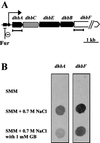
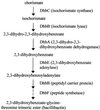

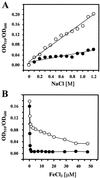
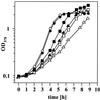

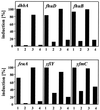

Similar articles
-
Interaction of Bacillus subtilis Fur (ferric uptake repressor) with the dhb operator in vitro and in vivo.J Bacteriol. 1999 Jul;181(14):4299-307. doi: 10.1128/JB.181.14.4299-4307.1999. J Bacteriol. 1999. PMID: 10400588 Free PMC article.
-
The dhb operon of Bacillus subtilis encodes the biosynthetic template for the catecholic siderophore 2,3-dihydroxybenzoate-glycine-threonine trimeric ester bacillibactin.J Biol Chem. 2001 Mar 9;276(10):7209-17. doi: 10.1074/jbc.M009140200. Epub 2000 Dec 8. J Biol Chem. 2001. PMID: 11112781
-
Sequence and genetic organization of a Bacillus subtilis operon encoding 2,3-dihydroxybenzoate biosynthetic enzymes.Gene. 1996 Oct 31;178(1-2):119-23. doi: 10.1016/0378-1119(96)00349-6. Gene. 1996. PMID: 8921902
-
How we learnt about iron acquisition in Pseudomonas aeruginosa: a series of very fortunate events.Biometals. 2007 Jun;20(3-4):587-601. doi: 10.1007/s10534-006-9067-2. Epub 2006 Dec 22. Biometals. 2007. PMID: 17186376 Review.
-
Gene regulation of siderophore-mediated iron acquisition in Pseudomonas: not only the Fur repressor.Mol Microbiol. 1995 Aug;17(4):603-10. doi: 10.1111/j.1365-2958.1995.mmi_17040603.x. Mol Microbiol. 1995. PMID: 8801415 Review.
Cited by
-
Amide compound synthesis by adenylation domain of bacillibactin synthetase.J Antibiot (Tokyo). 2017 Apr;70(4):435-442. doi: 10.1038/ja.2016.117. Epub 2016 Oct 12. J Antibiot (Tokyo). 2017. PMID: 27731335
-
A Positively Selected fur-R88H Mutation Enhances Helicobacter pylori Fitness in a High-Salt Environment and Alters Fur-Dependent Regulation of Gene Expression.Infect Immun. 2023 Feb 16;91(2):e0042022. doi: 10.1128/iai.00420-22. Epub 2023 Jan 12. Infect Immun. 2023. PMID: 36633416 Free PMC article.
-
Recognition of DNA by Fur: a reinterpretation of the Fur box consensus sequence.J Bacteriol. 2002 Nov;184(21):5826-32. doi: 10.1128/JB.184.21.5826-5832.2002. J Bacteriol. 2002. PMID: 12374814 Free PMC article.
-
Metabolic shift of Escherichia coli under salt stress in the presence of glycine betaine.Appl Environ Microbiol. 2014 Aug;80(15):4745-56. doi: 10.1128/AEM.00599-14. Appl Environ Microbiol. 2014. PMID: 24858086 Free PMC article.
-
Phylogenetic detection of conserved gene clusters in microbial genomes.BMC Bioinformatics. 2005 Oct 3;6:243. doi: 10.1186/1471-2105-6-243. BMC Bioinformatics. 2005. PMID: 16202130 Free PMC article.
References
-
- Alice, A. F., and C. Sanchez-Rivas. 1997. DNA supercoiling and osmoresistance in Bacillus subtilis 168. Curr. Microbiol. 35:309–315. - PubMed
-
- Bloom, H., H. Beier, and H. Gross. 1987. Improved silver staining of plant proteins, RNA and DNA in polyacrylamide gels. Electrophoresis 8:93–99.
Publication types
MeSH terms
Substances
LinkOut - more resources
Full Text Sources
Medical
Molecular Biology Databases

